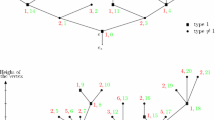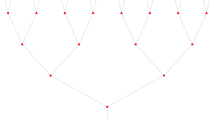Abstract
In this paper we deal with a random walk in a random environment on a super-critical Galton–Watson tree. We focus on the recurrent cases already studied by Hu and Shi (Ann. Probab. 35:1978–1997, 2007; Probab. Theory Relat. Fields 138:521–549, 2007), Faraud et al. (Probab. Theory Relat. Fields, 2011, in press), and Faraud (Electron. J. Probab. 16(6):174–215, 2011). We prove that the largest generation entirely visited by these walks behaves like logn, and that the constant of normalization, which differs from one case to another, is a function of the inverse of the constant of Biggins’ law of large numbers for branching random walks (Biggins in Adv. Appl. Probab. 8:446–459, 1976).

Similar content being viewed by others
References
Biggins, J.D.: The first- and last-birth problems for a multitype age-dependent branching branching process. Adv. Appl. Probab. 8, 446–459 (1976)
Biggins, J.D., Kyprianou, A.E.: Senata-heyde norming in the branching random walk. Ann. Probab. 25, 337–360 (1997)
Le Cam, L.: An approximation theorem for Poisson binomial distribution. Pac. J. Math. 10, 1181–1197 (1960)
Faraud, G.: A central limit theorem for random walk in a random environment on marked Galton-Watson trees. Electron. J. Probab. 16(6), 174–215 (2011)
Faraud, G., Hu, Y., Shi, Z.: Almost sure convergence for stochastically biased random walks on trees. Probab. Theory Relat. Fields (2011). doi:10.1007/s00440-011-0379-y
Hu, Y., Shi, Z.: Slow movement of recurrent random walk in random environment on a regular tree. Ann. Probab. 35, 1978–1997 (2007)
Hu, Y., Shi, Z.: A subdiffusive behavior of recurrent random walk in random environment on a regular tree. Probab. Theory Relat. Fields 138, 521–549 (2007)
Hu, Y., Shi, Z.: Minimal position and critical martingale convergence in branching random walks, and directed polymers on disordered trees. Ann. Probab. 37, 742–789 (2009)
Kesten, H., Stigum, B.P.: A limit theorem for multidimensional Galton-Watson processes. Ann. Math. Stat. 37, 1211–1223 (1966)
Lyons, R., Pemantle, R.: Random walk in a random environment and first-passage percolation on trees. Ann. Probab. 20, 125–136 (1992)
McDiarmid, C.: Minimal position in a branching random walk. Ann. Appl. Probab. 5(1), 128–139 (1995)
Menshikov, M.V., Petritis, D.: On random walks in random environment on trees and their relationship with multiplicative chaos. In: Mathematics and Computer Science II, pp. 415–422 (2002)
Rozikov, U.A.: Random walk in random environments on the Cayley tree. Ukr. Math. J. 53, 1688–1702 (2001)
Shi, Z.: Random walks and trees. Lectures (2010, preprint)
Acknowledgements
We would like to thank J.-B. Gouéré for having several discussions on branching random walks, and Thomas Haberkorn for useful numerical simulations.
Author information
Authors and Affiliations
Corresponding author
Appendix A
Appendix A
In this appendix, for completeness, we describe and sketch the proof of some classical results. Given a vertex \(x\in\mathbb{T}\), we denote by x 0:=ϕ,…,x n :=x the vertices on 〚ϕ,x〛 with |x i |=i for all 0≤i≤n.
1.1 A.1 Biggins–Kyprianou Identities
For any n≥1 and any measurable function F:ℝn×ℝn→[0,+∞), the Biggins–Kyprianou identity is given by
where (S i −S i−1) i≥1, are i.i.d. random variables, and the distribution of S 1 is determined by
for any measurable function f:ℝ→[0,+∞). A proof can be found in [2]; see also [14].
1.2 A.2 Classical Results About Birth and Death Chains
Lemma A.6
For x′∈〚ϕ,x〛:


where the \(x^{\prime}_{x}\) are the only children of x′ in 〚x′,x〛.
Proof
Let (σ
n
)
n≥0 be the family of stopping times defined by  and define \(Z_{n}=X_{\sigma_{n}}\) for n≥0. (Z
n
)
n≥0 is a birth and death Markov chain on 〚ϕ,x〛 with transition probabilities given by
and define \(Z_{n}=X_{\sigma_{n}}\) for n≥0. (Z
n
)
n≥0 is a birth and death Markov chain on 〚ϕ,x〛 with transition probabilities given by

∀1≤i≤n−1 and p ϕ =q x =1. Indeed

Let us introduce
and consider f:ℕ→ℝ given by f(ϕ)=0; for \(1\leq k\leq n,f(x_{k})=\sum_{\ell=0}^{k-1}\xi_{\ell}\). We easily see that (f(Z k )) k≥0 is a martingale. With τ i =inf{m≥,0,Z m =x i } and for 1≤i<j<k, according to the Optional Stopping Time Theorem, for 1≤i<j<k:

recalling that  . Since {τ
x
<τ
x′}={T
x
<T
x′} conditionally on {X
0=x′
x
}, formula (A.3) is proved. □
. Since {τ
x
<τ
x′}={T
x
<T
x′} conditionally on {X
0=x′
x
}, formula (A.3) is proved. □
1.3 A.3 About (γ n ,n)
Let us define
Lemma A.7
Assuming ψ(1)=0:
This result is already proved in the case of a b-ary tree (see for instance [6]). Here, we treat the case of a Galton–Watson tree.
Proof
First, observe that for all 2≤k≤n:

where K is a constant satisfying \(\forall x\in\mathbb {T},p(x,\overset {\leftarrow}{x})^{-1}\leq K\). The existence of K is provided by assumptions (1.1).
As p(ϕ,ϕ i)≤A(ϕ i), ∀1≤i≤N, we deduce from (A.5):
and note that formula (A.5) implies
Then from (A.8) and (A.9), we deduce formula (A.7) for k=2:

Assume that (A.7) is true for a certain k≥2 ; we prove that it still true for k+1. Using again (A.9):

Applying formula (A.7) to k=n and recalling that γ n (x)=0 for |x|=n:

where M j :=∑|x|=j ∏〛ϕ,x〛 A(y). (M j ) j≥1 is a positive \(\mathcal{F}_{j}\)-martingale with M 0=1 and \(\mathcal{F}_{j}:=\sigma\{(A(x^{1}),\ldots, A(x^{N_{x}}),N_{x}): \vert x\vert\leq j,x\in\mathbb{T}\}\). We now may state:
-
obviously we have positivity and for all j≥0, \(M_{j}\in \mathcal{F}_{j}\);
-
for all x∈T, as \((A(x^{1}),\ldots, A(x^{N_{x}}),N_{x})\) is equal in law to the vector (A 1,…,A N ,N):
$$\mathbb{E}[M_{j+1}\vert\mathcal{F}_j] =M_j \mathbb{E}\Biggl[\sum_{i=1}^{N}A_i \Biggr], $$and we conclude with \(M_{0}=\mathbb{E}[\sum_{i=1}^{N}A_{i}]=1\), since ψ(1)=0.
Consequently, there exists an almost sure limit for (M j ) j≥0, which implies that sup j M j <∞ almost surely.
Thus, (A.10) implying \(\frac{\gamma_{n}(\phi)}{n}\leq K \sup _{j}M_{j}\), we see that the proof is complete. □
Rights and permissions
About this article
Cite this article
Andreoletti, P., Debs, P. The Number of Generations Entirely Visited for Recurrent Random Walks in a Random Environment. J Theor Probab 27, 518–538 (2014). https://doi.org/10.1007/s10959-012-0449-9
Received:
Revised:
Published:
Issue Date:
DOI: https://doi.org/10.1007/s10959-012-0449-9




